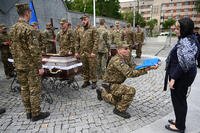It's a scene that's been repeated thousands of times on hundreds of battlefields: A soldier is hit by gunfire or shrapnel. He calls out for a medic, who tries to stabilize him on the spot and arranges for the injured warrior to be taken to a field hospital. And then, the soldier is gone -- maybe for the rest of the conflict.
But with the pace of American military missions getting faster and faster, losing GIs to injuries becomes an increasingly ugly option: Units that stay together fight better, military analysts say. And with soldiers operating in smaller groups -- think of the Special Forces combing the mountains of Afghanistan -- there often isn't a medic around to provide aid.
So Pentagon-funded scientists and doctors are working on a suite of technologies and treatments to let soldiers heal themselves, just about instantly. Acute pain and blood loss will be controlled in five minutes or less, if the program is successful. And an injured GI, assuming the wounds are not too severe, can stay alive and fighting on the battlefield for up to 96 hours -- without the help of a medic, without being evacuated.
The technologies, developed under a broad Defense Advanced Research Projects Agency effort called Persistence in Combat, all sound pretty far-fetched: a painkiller soldiers could take -- before they get hurt; a sensor that scans the eye for internal trauma; a bandage that stimulates skin repair with electrical impulses. But several of these projects are surprisingly close to reality, with human trials either underway or about to begin.
My Wired News article has more.
SAVING PVT. RYAN... FROM PAIN
© Copyright 2024 Military.com. All rights reserved. This article may not be republished, rebroadcast, rewritten or otherwise distributed without written permission. To reprint or license this article or any content from Military.com, please submit your request here.








